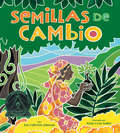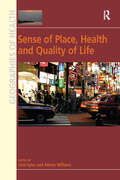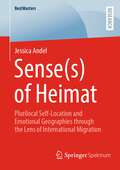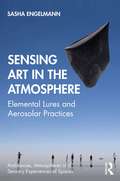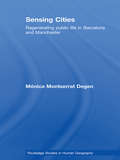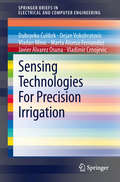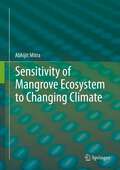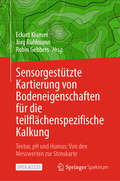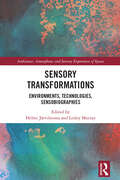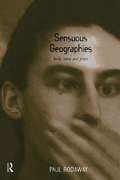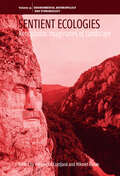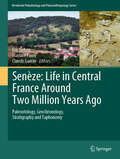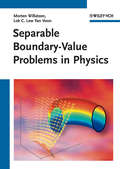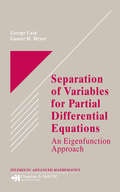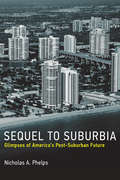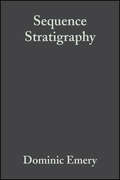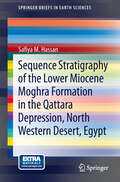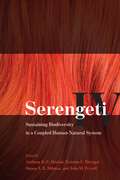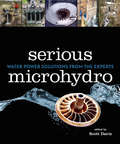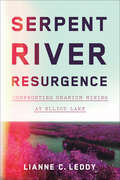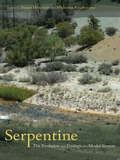- Table View
- List View
Semillas de cambio: Sembrando un camino hacia la paz (Seeds of Change: Planting a Path to Peace)
by Jen Cullerton JohnsonJohn Steptoe Award for New Talent in Illustrations - American Library Association (ALA)Una biografía ilustrada de la científica Wangari Maathai, la primera mujer africana (y la primera ambientalista) en ganar el Premio Nobel de la Paz por su trabajo sembrando árboles en su Kenia natal. A picture book biography of scientist Wangari Maathai, the first African woman--and first environmentalist--to win a Nobel Peace Prize for her work planting trees in her native Kenya.Cuando era niña en Kenia, a Wangari le enseñaron a respetar la naturaleza. Creció amando la tierra, las plantas y los animales que la rodeaban, desde los gigantescos árboles mugumo que su pueblo, Kikuyu, veneraban hasta los diminutos renacuajos que nadaban en el río. Aunque la mayoría de las niñas kenianas no recibieron educación, a Wangari, curiosa y trabajadora, se le permitió ir a la escuela. Allí su mente brotó como una semilla. Destacó en las ciencias y continuó sus estudios en los Estados Unidos. Después de regresar a casa, Wangari abrió un camino a través de Kenia, utilizando su conocimiento y compasión para promover los derechos de sus compatriotas y ayudar a salvar la tierra, un árbol a la vez. Semillas de cambio: Sembrando un camino hacia la paz le da vida a la historia poderosa de Wangari Maathai, la primera mujer africana y ambientalista en ganar un Premio Nobel de la Paz. Una narrativa cautivadora e imágenes vibrantes pintan un retrato sólido de esta inspiradora defensora de la tierra y de los derechos de las mujeres. As a young girl in Kenya, Wangari was taught to respect nature. She grew up loving the land, plants, and animals that surrounded her-from the giant mugumo trees her people, the Kikuyu, revered to the tiny tadpoles that swam in the river. Although most Kenyan girls were not educated, Wangari, curious and hardworking, was allowed to go to school. There, her mind sprouted like a seed. She excelled at science and went on to study in the United States. After returning home, Wangari blazed a trail across Kenya, using her knowledge and compassion to promote the rights of her countrywomen and to help save the land, one tree at a time. Seeds of Change: Planting a Path to Peace brings to life the empowering story of Wangari Maathai, the first African woman, and environmentalist, to win a Nobel Peace Prize. Engaging narrative and vibrant images paint a robust portrait of this inspiring champion of the land and of women's rights.
Sense of Place, Health and Quality of Life (Geographies of Health Series)
by Allison WilliamsA significant body of theoretical and empirical studies describes 'sense of place' as an outcome of interconnected psychological, social and environmental processes in relation to physical place(s). Sense of place has been examined, particularly in human geography, in terms of both the character intrinsic to a place as a localized, bounded and material entity, and the sentiments of attachment/detachment that humans experience and express in relation to specific places. Scholars in a wide range of disciplines are increasingly exploring the relationship between place and health, and recently, the field of public health has been encouraged to recognize sense of place as a potential contributing factor to well-being. It is evident that over the last few decades, sense of place has developed into a versatile construct. This important book brings together work related to sense of place and health, broadly defined, from the perspective of a variety of fields and disciplines. It will give the reader an understanding of both the range of applications of this construct within approaches to human health as well as the breadth of research methodologies employed in its investigation.
Sense: Plurilocal Self-Location and Emotional Geographies through the Lens of International Migration (BestMasters)
by Jessica AndelThe German notion of ‘Heimat’ is highly subjective, ambiguous and historically charged. Senses of belonging and identity associated with Heimat render the concept vulnerable to appropriation and instrumentalization by different political forces. Thereby, a static and exclusive understanding of Heimat is often depicted. This book drafts a counternarrative to demystify the contested concept. On the one hand, Heimat is conceptualized as spatial through emotional-geographical approaches to human-place relations. And on the other hand, the concept is placed in a global context through the perspective of international migration. The author contributes to the understanding of Heimat as an emotional map of self-location. This subjective map is neither purely static nor dynamic - it is characterized by simultaneities of opposing processes.
Sensing Art in the Atmosphere: Elemental Lures and Aerosolar Practices (Ambiances, Atmospheres and Sensory Experiences of Spaces)
by Sasha EngelmannThis book engages artistic interventions in the aerial elements to investigate the aesthetics and politics of atmosphere. Sensing Art in the Atmosphere: Elemental Lures and Aerosolar Practices traces the potential of artistic, community-driven experiments to amplify our sensing of atmosphere, marrying attentions to atmospheric affect with visceral awareness of the materials, institutions and processes hovering in the air. Drawing on six years of practice-led research with artistic and activist initiatives Museo Aero Solar and Aerocene, initiated by artist Tomás Saraceno, each chapter develops creative relations to atmosphere from the studio to stratospheric currents. Through narrative-led writing, the voices of artists and collaborators are situated and central. In dialogue with these aerographic stories and sites, the book develops a notion of elemental lures: the sensual and imaginative propositions of aerial, atmospheric and meteorological phenomena. The promise of elemental lures, Engelmann suggests, is to reconcile our sensing of atmosphere with the myriad social, cultural and political forces suspended in it. Through tales of floating journeys, shared envelopes of breath and surreal levitations, the book foregrounds the role of art in crafting alternative modes of perceiving, moving and imagining (in) the air. The book ends with a call for elemental experiments in the geohumanities. It makes an important and original contribution to elemental geographies, the geohumanities and interdisciplinary scholarship on air and atmosphere.
Sensing Cities: Regenerating Public Life in Barcelona and Manchester (Routledge Studies in Human Geography #14)
by Monica DegenAs cities globally re-design their urban landscapes, they produce a different urban aesthetic and create new experiential milieus. Urban regeneration processes generate radical physical, social and cultural changes in neighbourhoods that demand new conceptual frameworks to address their impact upon daily urban life. Sensing Cities investigates the reconfiguration of contemporary public space and life through the prism of the senses. The book explores how the increased stylization of cityscapes requires an understanding of public life as a spatial-sensuous encounter. Degen examines how power relations in public spaces are embedded in, exercised and resisted through the sensuous geography of place. This sensory paradigm is then applied to compare two emblematic regeneration projects, namely el Raval in Barcelona and Castlefield in Manchester. By combining detailed ethnographic analysis and interviews with those involved in planning regeneration processes and those experiencing them, the book argues that a changing sensuous landscape is crucial in redefining people’s social practices, attachments and experiences in places. Focusing on two European cities at the forefront of urban design, Barcelona and Manchester, Degen draws on sociology, geography, anthropology, cultural and architectural studies to provide a critical account of the politics of publicness in the entrepreneurial city. With numerous photographs and maps this book stresses the ongoing, embodied and active nature of regeneration as a lived social process rather than merely a physical or economic exercise. Ultimately, Sensing Cities examines how urban regeneration is made effective through the organisation of sensory experience. This book is essential reading for students and researchers of Architecture, Urban Studies and Human Geography.
Sensing Disaster: Local Knowledge and Vulnerability in Oceania
by Matthew LauerIn 2007, a three-story-high tsunami slammed the small island of Simbo in the western Solomon Islands. Drawing on over ten years of research, Matthew Lauer provides a vivid and intimate account of this calamitous event and the tumultuous recovery process. His stimulating analysis surveys the unpredictable entanglements of the powerful waves with colonization, capitalism, human-animal communication, spirit beings, ancestral territory, and technoscientific expertise that shaped the disaster’s outcomes. Although the Simbo people had never experienced another tsunami in their lifetimes, nearly everyone fled to safety before the destructive waves hit. To understand their astonishing response, Lauer argues that we need to rethink popular and scholarly portrayals of Indigenous knowledge to avert epistemic imperialism and improve disaster preparedness strategies. In an increasingly disaster-prone era of ecological crises, this provocative book brings new possibilities into view for understanding the causes and consequences of calamity, the unintended effects of humanitarian recovery and mitigation efforts, and the nature of local knowledge.
Sensing Technologies For Precision Irrigation
by Dejan Vukobratovic Marta Alonso Fernandez Vladan Minic Dubravko Ćulibrk Vladimir Crnojevic Javier Alvarez OsunaThis brief provides an overview of state-of-the-art sensing technologies relevant to the problem of precision irrigation, an emerging field within the domain of precision agriculture. Applications of wireless sensor networks, satellite data and geographic information systems in the domain are covered. This brief presents the basic concepts of the technologies and emphasizes the practical aspects that enable the implementation of intelligent irrigation systems. The authors target a broad audience interested in this theme and organize the content in five chapters, each concerned with a specific technology needed to address the problem of optimal crop irrigation. Professionals and researchers will find the text a thorough survey with practical applications.
Sensitivity of Mangrove Ecosystem to Changing Climate
by Abhijit MitraMangroves are basically salt tolerant forest ecosystems found mainly in tropical and sub-tropical inter-tidal regions. Till about 1960s, mangroves were largely viewed as "economically unproductive areas" and were therefore destroyed for reclaiming land for various economic and commercial activities. Gradually, with the passage of time, the economic and ecological benefits of mangroves have become visible and their importance is now well appreciated. Today, mangroves are observed in about 30 countries in tropical subtropical regions covering an area of about 99,300 Sq.Km. However, during the past 50 years, over 50% of the mangrove cover has been lost, mainly because of the increased pressure of human activities like shrimp farming and agriculture, forestry, salt extraction, urban development, tourist development and infrastructure. Also, dam on rivers, contamination of sea waters caused by heavy metals, oil spills, pesticides and other products etc. have been found to be responsible for the decline of mangroves. Although the temperature effect on growth and species diversity is not known, sea-level rise may pose a serious threat to these ecosystems The present book addresses all these important issues in separate chapters with some interesting case studies whose data may serve as pathfinder for future researches in the sphere of the influence of climate change on mangrove ecosystem. The role of mangroves in the sector of bioremediation is a unique feather in the crown of this coastal and brackishwater vegetation that may be taken up by the coastal industries in order to maintain the health of ambient environment. This book seeks to discover and to assess the vulnerability of climate change on mangrove flora and fauna, their role in carbon sequestration and some interesting case studies by some groups of dedicated researchers that may serve as the basis of future climate related policies.
Sensorgestützte Kartierung von Bodeneigenschaften für die teilflächenspezifische Kalkung: Textur, pH und Humus: Von den Messwerten zur Streukarte
by Eckart Kramer Jörg Rühlmann Robin GebbersDieses Open Access Buch vermittelt fundierte Grundlagen und praxisorientierte Anleitungen für die genaue Kartierung von Ackerflächen auf der Grundlage von Bodenparametern wie Textur, pH-Wert und Humusgehalt. Es werden die gegenwärtig bestgeeigneten Kartierungsverfahren beschrieben. Von der Bereinigung der Bodensensordaten bis hin zur Erstellung von Streukarten und der Auswahl des optimalen Kalkdüngers wird jeder Schritt des Prozesses detailliert erklärt. Sämtliche Funktionen und Algorithmen zum Buch sind als “R”-Skripte via Download verfügbar. Mit Hilfe von Beispieldaten und einem Tutorial kann die Prozesskette zur Streukartenerstellung mit der freien Softwareumgebung “R” als Einstieg in mathematische Methoden des Precision Farming, u.a. räumliche Statistik und Entscheidungsunterstützungsalgorithmen, nachvollzogen werden. Darüber hinaus bietet dieses Buch praktische Einblicke in die landwirtschaftliche Praxis, indem es die Bedeutung präziser Bodentexturkarten für eine effiziente Grunddüngung erläutert. Anhand von anschaulichen Praxisbeispielen werden die Auswirkungen ungenauer Bodeninformationen auf die Nährstoffversorgung des Bodens und die Umwelt verdeutlicht. Mit seinem ganzheitlichen Ansatz liefert dieses Buch nicht nur praktische Anleitungen, sondern auch wertvolles Hintergrundwissen zu Fachthemen wie Bodenacidität, Kalkdüngestoffen und Kartierungsmethoden. Es ist ein idealer Begleiter für Landwirt*innen, Berater*innen und Wissenschaftler*innen, die ihre landwirtschaftlichen Praktiken optimieren und ihre Erträge steigern möchten.
Sensory Transformations: Environments, Technologies, Sensobiographies (Ambiances, Atmospheres and Sensory Experiences of Spaces)
by Lesley Murray Helmi JärviluomaThis book offers original insights into cultural transformations of the sensory with particular emphasis on environments and technologies, articulating a special moment in the sensory history of urban Europe as people’s relationship with their environment is increasingly shaped through digital technologies. It is a much-needed addition to Sensory Studies literature with its firmly grounded empirical and theoretical perspectives. It provides radical and impactful food for thought on sensory engagements with urban environments. After reading the book, the reader will have a profound understanding of the original methodology of sensobiographic walking, as well as transdisciplinary and transgenerational ethnographies in different cultural contexts – in this case three European cities. The book is aimed at a large audience of readers. It is equally useful for social and human scientists and students finalizing their MA degrees or working on their doctoral or post-doctoral work, and essential reading for environmental planners, youth workers, city planners and architects, among others.
Sensuous Geographies: Body, Sense and Place
by Paul RodawayThe contemporary challenge of postmodernity draws our attention to the nature of reality and the ways in which experience is constructed. Sensuous Geographies explores our immediate sensuous experience of the world. Touch, smell, hearing and sight - the four senses chiefly relevant to geographical experience - both receive and structure information. The process is mediated by historical, cultural and technological factors. Issues of definition are illustrated through a variety of sensuous geographies. Focusing on postmodern concerns with representation, the book brings insights from individual perceptions and cultural observations to an analysis of the senses, challenging us to reconsider the role of the sensuous as not merely the physical basis of understanding but as an integral part of the cultural definition of geographical knowledge.
Sentient Ecologies: Xenophobic Imaginaries of Landscape (Environmental Anthropology and Ethnobiology #31)
by Alexandra Coțofană Hikmet KuranEmploying methodological perspectives from the fields of political geography, environmental studies, anthropology, and their cognate disciplines, this volume explores alternative logics of sentient landscapes as racist, xenophobic, and right-wing. While the field of sentient landscapes has gained critical attention, the literature rarely seems to question the intentionality of sentient landscapes, which are often romanticized as pure, good, and just, and perceived as protectors of those who are powerless, indigenous, and colonized. The book takes a new stance on sentient landscapes with the intention of dispelling the denial of “coevalness” represented by their scholarly romanticization.
Senèze: Paleontology, Geochronology, Stratigraphy and Taphonomy (Vertebrate Paleobiology and Paleoanthropology)
by Eric Delson Martine Faure Claude GuérinThe paleontological site of Senèze (Haute Loire, central France) was discovered in 1892 inside a volcanic crater. For over 40 years, local peasant Pierre Philis collected fossils and sold them to French and Swiss museums. The site became world-famous for its well-preserved skeletons of ungulates and carnivores, as well as rare but well-preserved remains of primates and other mammals. It is considered the reference fauna for the late Villafranchian and MNQ 18 biochronological units of European mammalian evolution, but the lack of provenance data made modern research difficult. From 2000-2006, the multidisciplinary Franco-American Senèze Research Project undertook five seasons of major fieldwork, with the goals of clarifying the age, stratigraphy and taphonomy of Senèze, as well as finding additional remains, especially of the less well-known taxa. In this volume, following a history of study and summary of the new fieldwork, four geological chapters consider field methods, stratigraphy, volcanology and dating. Combining argon-argon ages and paleomagnetic calibration, the newly recovered fossils are shown to date between 2.20 and 2.08 Ma, with concentrations ca. 2.20-2.18 and 2.10-2.08 Ma, significantly older than previously thought. Chapters on palynology, ichthyology and ornithology are followed by eight chapters on the fossil mammals. The chapter on biochronology places Senèze among other sites at the start of MNQ 18, which is estimated to end ca. 1.7 Ma. Of some 2200 specimens known from the site, over half are cervids, with bovids, rhinocerotids and equids far behind. According to data from palynology and the habitat preferences of the more common mammals, the paleoenvironment around the Senèze maar would have included forest, woodland and grassland, perhaps in a warmer and moister climate than today. Taphonomic studies revealed that bones often rested a long time under water, lacked any indication of carnivore attack and often displayed pathologies in their joints. It is likely that most of the associated skeletons were preserved undisturbed after large mammals fell into the paleolake and drowned without being able to climb out. This book responds to the long-held desire of later Cenozoic paleontologists to see a modern study of a site recognized worldwide as a biochronologic reference for the Plio-Pleistocene. Our study required renewed fieldwork using up to date techniques of topography, sedimentology, stratigraphy, geochronology and taphonomy. The systematic paleontology chapters are based on re-study of the entire body of Senèze fossils collected during more than a century of research. The volume will be of interest to paleontologists, especially those concerned with the evolution of the European fauna and with the taxa studied, as well as with paleoenvironmental reconstruction and biogeography. It will also be of value to mammalogists interested in analyses of near-modern taxa and to paleoanthropologists, archaeologists and taphonomists interested in the methods utilized and the role of Senèze as a comparative standard for a site of this age without human intervention. It will surely be an essential reference for all those who want to know more about Life in Central France Around Two Million Years Ago.
Separable Boundary-Value Problems in Physics
by Morten Willatzen Lok C. Lew Yan VoonInnovative developments in science and technology require a thorough knowledge of applied mathematics, particularly in the field of differential equations and special functions. These are relevant in modeling and computing applications of electromagnetic theory and quantum theory, e.g. in photonics and nanotechnology. The problem of solving partial differential equations remains an important topic that is taught at both the undergraduate and graduate level. Separable Boundary-Value Problems in Physics is an accessible and comprehensive treatment of partial differential equations in mathematical physics in a variety of coordinate systems and geometry and their solutions, including a differential geometric formulation, using the method of separation of variables. With problems and modern examples from the fields of nano-technology and other areas of physics. The fluency of the text and the high quality of graphics make the topic easy accessible. The organization of the content by coordinate systems rather than by equation types is unique and offers an easy access. The authors consider recent research results which have led to a much increased pedagogical understanding of not just this topic but of many other related topics in mathematical physics, and which like the explicit discussion on differential geometry shows - yet have not been treated in the older texts. To the benefit of the reader, a summary presents a convenient overview on all special functions covered. Homework problems are included as well as numerical algorithms for computing special functions. Thus this book can serve as a reference text for advanced undergraduate students, as a textbook for graduate level courses, and as a self-study book and reference manual for physicists, theoretically oriented engineers and traditional mathematicians.
Separation of Variables for Partial Differential Equations: An Eigenfunction Approach
by George Cain Gunter H. MeyerSeparation of Variables for Partial Differential Equations: An Eigenfunction Approach includes many realistic applications beyond the usual model problems. The book concentrates on the method of separation of variables for partial differential equations, which remains an integral part of the training in applied mathematics. Beyond the usual model p
Sequel to Suburbia: Glimpses of America's Post-Suburban Future (Urban and Industrial Environments)
by Nicholas A. PhelpsHow the decentralized, automobile-oriented, and fuel-consuming model of American suburban development might change.In the years after World War II, a distinctly American model for suburban development emerged. The expansive rings of outer suburbs that formed around major cities were decentralized and automobile oriented, an embodiment of America's postwar mass-production, mass-consumption economy. But alternate models for suburbia, including “transit-oriented development,” “smart growth,” and “New Urbanism,” have inspired critiques of suburbanization and experiments in post-suburban ways of living. In Sequel to Suburbia, Nicholas Phelps considers the possible post-suburban future, offering historical and theoretical context as well as case studies of transforming communities.Phelps first locates these outer suburban rings within wider metropolitan spaces, describes the suburbs as a “spatial fix” for the postwar capitalist economy, and examines the political and governmental obstacles to reworking suburban space. He then presents three glimpses of post-suburban America, looking at Kendall-Dadeland (in Miami-Dade County, Florida), Tysons Corner (in Fairfax County, Virginia), and Schaumburg, Illinois (near Chicago). He shows Kendall-Dadeland to be an isolated New Urbanism success; describes the re-planning of Tysons Corner to include a retrofitted central downtown area; and examines Schaumburg's position as a regional capital for Chicago's northwest suburbs. As these cases show, the reworking of suburban space and the accompanying political process will not be left to a small group of architects, planners, and politicians. Post-suburban politics will have to command the approval of the residents of suburbia.
Sequence Stratigraphy
by Keith Myers Dominic EmeryThe innovation and refinement of the techniques and concepts of sequence stratigraphy has been one of the most exciting and profound developments in geology over the past thirty years. Seismic stratigraphy has now become one of the standard tools of the geoscientist, and there is a pressing need for an introductory text on sequence stratigraphy. This new book sets out to define and explain the concepts, principles and applications of this remarkably influential approach to the study of sedimentary strata. The authors take a rigorous objective stance in evaluating the techniques and interpretation of sequence stratigraphy - basing the text on an internal training course developed by British Petroleum (BP).
Sequence Stratigraphy of the Lower Miocene Moghra Formation in the Qattara Depression, North Western Desert, Egypt
by Safiya M. HassanThe Qattara Depression is part of the Northwestern Desert in Egypt and is home to the second lowest point in Africa at -133 meters below sea level. Therefore, before any projects can be carried out in this area, we must first understand the geology of the land. The present study deals with the high-resolution sequence stratigraphic analysis of the Lower Miocene Moghra Formation outcrops in the Qattara Depression Region. The literature on the sedimentology and sequence stratigraphy of the Moghra Formation has been sparse to date, despite some excellent work over the years by academic and petroleum workers. Moreover, the area studied is within what was once a front-line of World War II, where mine fields and war relics are scattered and cover wide reaches. This has resulted in limited geologic mapping in the past. Thus, great attention is paid in this study to establishing a robust sedimentology and high-resolution sequence stratigraphic framework for the Lower Miocene Moghra Formation. Included are works based on outcrops and, most importantly, new sedimentological and chronostratigraphic information not previously available.
Sequential Analysis and Observational Methods for the Behavioral Sciences
by Vicenç Quera Roger BakemanBehavioral scientists - including those in psychology, infant and child development, education, animal behavior, marketing and usability studies - use many methods to measure behavior. Systematic observation is used to study relatively natural, spontaneous behavior as it unfolds sequentially in time. This book emphasizes digital means to record and code such behavior; while observational methods do not require them, they work better with them. Key topics include devising coding schemes, training observers and assessing reliability, as well as recording, representing and analyzing observational data. In clear and straightforward language, this book provides a thorough grounding in observational methods along with considerable practical advice. It describes standard conventions for sequential data and details how to perform sequential analysis with a computer program developed by the authors. The book is rich with examples of coding schemes and different approaches to sequential analysis, including both statistical and graphical means.
Serengeti IV: Sustaining Biodiversity in a Coupled Human-Natural System
by John M. Fryxell Anthony R. E. Sinclair Kristine L. Metzger Simon A. R. MdumaThe vast savannas and great migrations of the Serengeti conjure impressions of a harmonious and balanced ecosystem. But in reality, the history of the Serengeti is rife with battles between human and non-human nature. In the 1890s and several times since, the cattle virus rinderpest at last vanquished in 2008 devastated both domesticated and wild ungulate populations, as well as the lives of humans and other animals who depended on them. In the 1920s, tourists armed with the world s most expensive hunting gear filled the grasslands. And in recent years, violence in Tanzania has threatened one of the most successful long-term ecological research centers in history. "Serengeti IV," the latest installment in a long-standing series on the region s ecology and biodiversity, explores the role of our species as a source of both discord and balance in Serengeti ecosystem dynamics. Through chapters charting the complexities of infectious disease transmission across populations, agricultural expansion, and the many challenges of managing this ecosystem today, this book shows how the people and landscapes surrounding crucial protected areas like Serengeti National Park can and must contribute to Serengeti conservation. In order to succeed, conservation efforts must also focus on the welfare of indigenous peoples, allowing them both to sustain their agricultural practices and to benefit from the natural resources provided by protected areas an undertaking that will require the strengthening of government and education systems and, as such, will present one of the greatest conservation challenges of the next century. "
Serengeti: Plains of Grass
by Leslie BulionAward-winning science poetry master Leslie Bulion presents a lyrical salute to Africa's Serengeti Plain, one of the most spectacular and productive ecosystems on Earth.Leslie Bulion, a virtuoso science poet, has created a portrait of the rainy season on East Africa's southern Serengeti Plain, offering young readers a compelling look at an ecosystem in motion. Using a series of interconnected verses inspired by an East African Swahili poem form—the utendi—Bulion's cadences and rhythmic lines mimic the web of life in the Serengeti, following the great migration of wildebeest, zebras, and other animals into and then out of the vast short-grass plain. Lush, evocative gouache illustrations by Becca Stadtlander showcase the grandeur of this immense and complex ecosystem and provide close-up details of its wildlife inhabitants. Scientific notes on each spread and comprehensive back matter material offer more specifics. This, paired with Bulion's brilliant poetic form, makes the book ideal for cross-curricular learning. A Booklist Editors&’ Choice Selection <P><P><i>Advisory: Bookshare has learned that this book offers only partial accessibility. We have kept it in the collection because it is useful for some of our members. Benetech is actively working on projects to improve accessibility issues such as these.</i>
Serious Leisure and Nature
by Robert A. Stebbins Lee DavidsonOutings in nature considered as leisure activity constitute a main way in which many people the world over presently use their free time. Nature is defined here as any natural setting perceived by users as at most only minimally modified by human beings. In its most general manifestation nature thus defined is composed of one or more of six elements: air, land, water, plants, animals (birds, fish) and snow or ice. Outdoor pursuits are immensely popular, especially among city dwellers. They are also widely discussed in leisure studies, where they have inspired considerable research. Still this research tends to lack a theoretic anchor, which this book provides through the new serious leisure concept of nature challenge activity (NCA). It examines several hundred NCAs and types of NCAs, setting out how meeting this challenge unfolds in an aesthetically appealing natural environment with notable implications for consumption and environmental sustainability.
Serious Microhydro
by Scott DavisWaterpower is the largest source of renewable energy in the world today, and microhydro is a mature, proven technology that can provide clean, inexpensive, renewable energy with little or no impact on the environment. Serious Microhydro brings you dozens of firsthand stories of energy independence covering a complete range of systems, from household pressure sites to higher pressure installations capable of powering a farm, business, or small neighborhood. Topics include: Low head and medium head sites AC-only systems as well as ones using a battery/inverter subsystem Stand alone power supply or grid intertie setups Hybrid systems (combined with photovoltaics or wind) With all the variables involved in microhydro, there is no "typical" system. These case studies represent the most comprehensive collection of knowledge and experience available for tailoring an installation to meet the needs of a site and its owner or operators. If you are considering building a system, you are bound to find a wealth of creative solutions appropriate to your own circumstances. Serious Microhydro shows how scores of people are achieving a high standard of living from local energy sources with a minimal ecological footprint. It has particular appeal to homeowners, teachers, renewable energy professionals, activists, and decision makers who want to understand the technology from a "hands-on" perspective. Scott Davis is an award-winning renewable energy project developer with decades of experience operating, installing, designing, selling, and teaching microhydro technology. He is a founder and president of Friends of Renewable Energy BC, and the author of Microhydro: Clean Power From Water.
Serpent River Resurgence: Confronting Uranium Mining at Elliot Lake
by Lianne C. LeddySerpent River Resurgence tells the story of how the Serpent River Anishinaabek confronted the persistent forces of settler colonialism and the effects of uranium mining at Elliot Lake, Ontario. Drawing on extensive archival sources, oral histories, and newspaper articles, Lianne C. Leddy examines the environmental and political power relationships that affected her homeland in the Cold War period. Focusing on Indigenous-settler relations, the environmental and health consequences of the uranium industry, and the importance of traditional uses of land and what happens when they are compromised, Serpent River Resurgence explores how settler colonialism and Anishinaabe resistance remained potent forces in Indigenous communities throughout the second half of the twentieth century.
Serpentine: The Evolution and Ecology of a Model System
by Susan Harrison Nishanta RajakarunaSerpentine soils have long fascinated biologists for the specialized floras they support and the challenges they pose to plant survival and growth. This volume focuses on what scientists have learned about major questions in earth history, evolution, ecology, conservation, and restoration from the study of serpentine areas, especially in California. Results from molecular studies offer insight into evolutionary patterns, while new ecological research examines both species and communities. Serpentine highlights research whose breadth provides context and fresh insights into the evolution and ecology of stressful environments.
